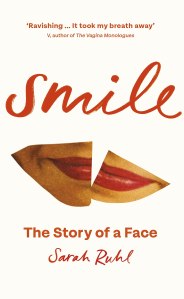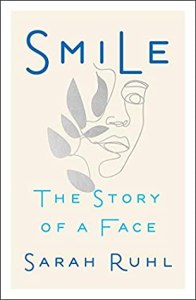Smile: The Story of a Face by Sarah Ruhl
“Ten years ago, my smile walked off my face, and wandered out in the world. This is the story of my asking it to come back.”
 Sarah Ruhl is a lauded New York City playwright (Eurydice et al.). These warm and beautifully observed autobiographical essays stem from the birth of her twins and the slow-burning medical crises that followed. Shortly after the delivery, she developed Bell’s palsy, a partial paralysis of the face that usually resolves itself within six months but in rare cases doesn’t go away, and later discovered that she had celiac disease and Hashimoto’s disease, two autoimmune disorders. Having a lopsided face, grimacing and squinting when she tried to show expression on her paralyzed side – she knew this was a minor problem in the grand scheme of things, yet it provoked thorny questions about to what extent the body equates to our identity:
Sarah Ruhl is a lauded New York City playwright (Eurydice et al.). These warm and beautifully observed autobiographical essays stem from the birth of her twins and the slow-burning medical crises that followed. Shortly after the delivery, she developed Bell’s palsy, a partial paralysis of the face that usually resolves itself within six months but in rare cases doesn’t go away, and later discovered that she had celiac disease and Hashimoto’s disease, two autoimmune disorders. Having a lopsided face, grimacing and squinting when she tried to show expression on her paralyzed side – she knew this was a minor problem in the grand scheme of things, yet it provoked thorny questions about to what extent the body equates to our identity:
Can one experience joy when one cannot express joy on one’s face? Does the smile itself create the happiness? Or does happiness create the smile?

As (pretty much) always, I prefer the U.S. cover.
Women are accustomed to men cajoling them into a smile, but now she couldn’t comply even had she wanted to. Ruhl looks into the psychology and neurology of facial expressions, such as the Duchenne smile, but keeps coming back to her own experience: marriage to Tony, a child psychiatrist; mothering Anna and twins William and Hope; teaching and writing and putting on plays; and seeking alternative as well as traditional treatments (acupuncture and Buddhist meditation versus physical therapy; she rejected Botox and experimental surgery) for the Bell’s palsy. By the end of the book she’s achieved about a 70% recovery, but it did take a decade. “A woman slowly gets better. What kind of story is that?” she wryly asks. The answer is: a realistic one. We’re all too cynical these days to believe in miracle cures. But a story of graceful persistence, of setbacks alternating with advances? That’s relatable.
The playwright’s skills are abundantly evident here: strong dialogue and scenes; a clear sense of time, such that flashbacks to earlier life, including childhood, are interlaced naturally; a mixture of exposition and forceful one-liners. She is also brave to include lots of black-and-white family photographs that illustrate the before and after. While reading I often thought of Lucy Grealy’s Autobiography of a Face and Terri Tate’s A Crooked Smile, which are both about life with facial deformity after cancer surgery. I’d also recommend this to readers of Flesh & Blood by N. West Moss, one of my 2021 favourites, and Anne Lamott’s essays on facing everyday life with wit and spiritual wisdom.
More lines I loved:
imperfection is a portal. Whereas perfection and symmetry create distance. Our culture values perfect pictures of ourselves, mirage, over and above authentic connection. But we meet one another through the imperfect particular of our bodies.
Lucky the laugh lines and the smile lines especially: they signify mobility, duration, and joy.
My rating: 
With thanks to Bodley Head for the free copy for review.
Born Digital by Robert Wigley (Blog Tour)
 Robert Wigley spent a career in finance and is a father to three teenage sons. For two years, he learned more about their generation by meeting with 200 young entrepreneurs, one per business day. That combination of research and personal experience fuels his first book, Born Digital, which is about the unique challenges faced by Generation Z.
Robert Wigley spent a career in finance and is a father to three teenage sons. For two years, he learned more about their generation by meeting with 200 young entrepreneurs, one per business day. That combination of research and personal experience fuels his first book, Born Digital, which is about the unique challenges faced by Generation Z.
He found that, with young people spending an average of seven hours a day online, technology can exacerbate mental health issues, especially with the doom and gloom and lack of authenticity found on social media. Rather than making people feel more connected, technology tends to increase loneliness and reduce face-to-face interactions. Popularity and hook-ups are sought over meaningful, long-term relationships, while multi-tasking leads to an overall lack of focus.
This book brings up so many issues, including the potential for online surveillance and manipulation, and the problem of anonymity plus a failure to effectively verify users’ age. I’m still a smartphone refusenik because I want to carefully guard my time and attention, so I was particularly interested in the statistics and stories Wigley conveys about what it’s like for young people who have grown up with smartphones. This is a book I’ll be keeping on the shelf for future reference. It would of course be very relevant to parents and teachers, but I found it enlightening as well. Here’s a few-page excerpt to whet your appetite.
Chapter 6
LET’S TALK ABOUT THE JUGGLER’S BRAIN
My youngest son is at home with my wife and me; my older two are in London. We are all glued to Chelsea (who they all avidly support) playing Manchester United in the semi-final of the FA Cup. Chelsea scores, and my son screams with excitement and then starts his hilarious victory dance in front of the TV. The family WhatsApp channel bursts into life. Ping, ping. My wife has sent a picture of my youngest in front of the TV. My eldest has replied saying ‘doing exactly the same’. Everyone is high on a cocktail of Chelsea scoring, WhatsApp pinging and the humorous pictures and messages that it conveys.
Pleasurable human experiences result in the release of dopamine in the brain. The dopamine attaching itself to receptors in the brain causes the feeling of pleasure we experience. Most pleasurable experiences cause the release of a small amount of dopamine. Broadly speaking, to start with, the more dopamine, the more pleasure.
Normally, this release of dopamine is a good thing. It encourages us to seek out what is healthy or beneficial in our environment. It’s so important, in fact, that neuroscientists have given it a central role in a type of fundamental human learning called reinforcement learning. I will explain how technology companies abuse reinforcement learning to modify human behaviour so that we maximise time on their platforms and apps. What scientists have found is that dopamine is related to the prediction of rewards. If a reward is received but not anticipated, an increase in dopamine is seen. And if a reward is anticipated and not seen, a decrease in dopamine is seen. Since our brains are wired to optimise rewards, this means that humans will be motivated to seek out new rewards in any given situation, do anything they know delivers a reward repeatedly and avoid anything which gives them negative effects. Technology companies design their platforms and apps to make them addictive using this science. Receiving a notification, a like on Facebook or Instagram, a match on Tinder or a win in Fortnite all trigger dopamine releases. Being blocked by a friend or killed in the game causes a decrease in dopamine.
The problem starts when you seek out dopamine regularly and repeatedly as most people could be tempted to, given the pleasurable effect. The brain starts to develop a tolerance for dopamine. So more dopamine is needed to generate the same degree of pleasure. In the natural world, the availability of rewards is largely out of humans’ hands. On technology platforms, it is designed in and can be made almost infinitely abundant. Addictions develop because two things happen. The brain produces less dopamine per stimulus, and the brain feels less stimulated by each new release. So more, larger stimuli are needed, requiring the addict to seek them.
Sean Parker, Facebook’s Founding President, said in 2017, ‘We need to give you a little dopamine hit every once in a while … exploiting a vulnerability in human psychology … the inventors, creators … understood it consciously. And we did it anyway. God only knows what it’s doing to our children’s brains.’
Mirror neurons fire in the brain when an animal acts and observes the same action in another. You smile, I smile back. This may explain why some people unwittingly imitate their companions, sitting similarly in terms of leg positions or with their heads cocked at a similar angle. Some neuroscientists believe that mirror neurons form the basis of emotions such as empathy. If true, to develop and display empathy requires the physical observation of a counterparty during the intercourse – something, of course, that social media chat doesn’t deliver.
While neuroscientists debate precise mechanisms, it seems reasonably well accepted that bonding situations – a mother feeding or hugging a child – result in the release of oxytocin, which itself triggers the release of dopamine and serotonin. This leads to pleasurable feelings of comfort and security and builds the bond between the baby and the parent or carer. We have seen that dopamine leads to pleasure, and serotonin boosts feelings of wellbeing and collegiality. Paul Zak, one of the original researchers into the effects of oxytocin, described this as Human Oxytocin Medicated Empathy (‘HOME’). Bonding and empathy require at least physical proximity or engaged face-to-face engagement to occur. This is one of the reasons why it is so important that babies are not distracted with iPads fixed inches in front of their faces in their recliners before they are two, and equally important that parents must not be distracted from fixing their baby’s gaze, eye to eye, by combining feeding or bonding time with use of their own devices.
Eye-to-eye contact seems to be critical not just as a baby, but throughout life. ‘Whether it’s affection, amusement, arrogance or annoyance, our eyes convey how we feel. And the ability to read another person’s eyes, face to face, is one of the best predictors of a person’s social intelligence,’ says King. Referring to the conclusions of Simon Baron-Cohen’s ‘reading the mind in the eye test’, she says. ‘The better you are at inferring someone else’s mental state by looking at their eyes, the more likely you are to be prosocial, perform well in groups and respond empathetically.’
My thanks to Midas PR for the proof copy. I was glad to take part in the blog tour. See below for details of where other reviews and features have appeared.
